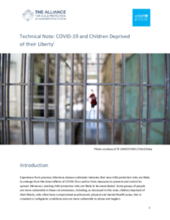Experience from previous infectious disease outbreaks indicates that new child protection risks are likely to emerge from the direct effects of COVID-19 as well as from measures to prevent and control its spread. Moreover, existing child protection risks are likely to be exacerbated. Some groups of people are more vulnerable in these circumstances, including, as discussed in this note, children deprived of their liberty, who often have compromised psychosocial, physical and mental health issues, live in crowded or unhygienic conditions and are more vulnerable to abuse and neglect.
Lessons learned from previous outbreaks emphasize the need for States to accommodate increased child protection needs when devising and implementing their response plans. Failure to address such needs or delayed implementation of coordinated responses can increase suffering, cause irreparable harm to children and can delay the recovery of whole communities.
In responding to the COVID-19 pandemic, States must ensure that the human rights of every child who is deprived of her or his liberty are fully respected, protected and fulfilled. This includes providing adequate care and protection from harm, including by taking concrete steps to reduce overcrowding in all facilities in which they are detained and ensuring safe placement in non-custodial, family or community-based settings. It also means that all decisions and actions concerning children must be guided by the principle of the best interests of the child, and children’s rights to life, survival, and development, and to be heard.
This note aims to provide detaining authorities with key information and steps to respond to COVID-19 including by:
- Instituting a moratorium on new children entering detention facilities;
- Releasing all children who can be safely released; and
- Protecting the health and well-being of any children who must remain in detention.
This technical note is an annex of the Technical Note: Protection of Children during the COVID-19 Pandemic.

